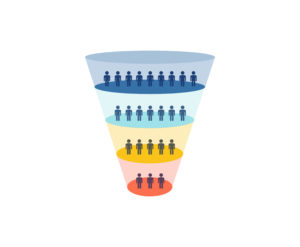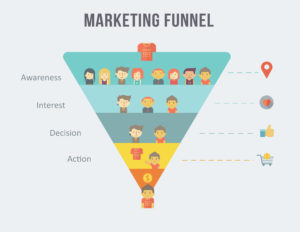
How to Improve Marketing for a Law Firm With a Multi-Channel Funnel Strategy
B2B marketers need to put a special emphasis on a well-structured funnel strategy. In order to attract leads and acquire new clients, a multi-channel strategy is important. By applying a full-funnel approach when marketing for a law firm, you can improve your efficiency and performance across brand awareness, lead generation, and client retention.
Improving Marketing for a Law Firm With a Multi-Channel Funnel Strategy
Why is the B2B Funnel Unique?
Keeping the marketing funnel full is essential for the health of your sales pipeline when trying to improve marketing for a law firm. That’s because the B2B sales cycle tends to be much longer than other sales processes. The client-facing sales cycle
An effective funnel will reach people across the following segments:
- Top of the funnel – Content and marketing activities focused on brand awareness and generating new prospects.
- Middle of the funnel – Called the consideration phase, these activities focus on lead generation through providing valuable advice.
- Bottom of the funnel – This tends to be where the deal is closed and tactics will move over to the sales team directly.
- Client retention – Once you secure a client, you want to keep them happy and encourage them to pursue repeat business and share referrals.
How to Improve Marketing for a Law Firm by Creating a Fully-Integrated Marketing Funnel
In order to unleash the full power of your marketing tactics, you need to implement a thoughtful strategy that can attract new leads, nurture current leads, and convert paying clients. Full-funnel marketing focuses on creating a seamless experience for prospects across every stage of the sales funnel. Start with these steps when creating content for marketing for a law firm.
1. Identify Your Ideal Clients
You need to know who you’re trying to reach. Start by reviewing your CRM or other internal data. Who are your best clients? What do they have in common? Consider their pain points and common challenges, and how your firm supports them. If you don’t have client personas developed, this would be a good place to start. As you consider how your firm helps clients, you can start to put together effective messaging.
To learn how to identify your ideal client, check out this free guide for creating an ideal client profile.
2. Focus on Specific Actions in the Funnel
At each stage of the funnel, what do you want people to do? At the end of their journey, what action are you hoping prospects take? Now, work backward from those actions. An impactful full-funnel marketing strategy has a clearly mapped out path for interested people to take. Successful integrated marketing funnels also take into account “if-then” scenarios. Consider all of your possible touchpoints, channels, and conversion criteria. A few other tips:
- Think about how the contact feels for a potential client. Don’t simply sell your services, but use communication opportunities to guide prospects through the experience.
- Leverage digital measurement tools such as Google Analytics or HubSpot to gain insights across digital channels when improving marketing for a law firm. You can use data to understand which channels perform well for you, where you have higher engagement, etc.
- Similarly, review your social media analytics to see where your audience spends time and how they interact with your firm on each platform.
- Combine all of that data with the CRM insights you already have to better understand how to interact with your target audience online.
3. Perform Competitor Analysis
Which companies share your ideal clients? Spend some time investigating what they do well, and where there are opportunities and gaps. Good tools for doing this type of research are the Facebook Ads Library or a simple Google search. This should give you an idea of what keywords your competitors are targeting, what their landing pages look like, and what calls-to-action they’re using. Of course, you don’t want to copy anyone, but don’t be afraid to take inspiration from other great marketing programs.
4. Create Compelling Sales Funnel Content
Now that you have a clear understanding of your target audience and what your competitors are doing, you can dive deeper on the sales journey you mapped out. At each stage, consider how you will encourage the prospect to take the desired action. Use these ideas when generating content:
- Awareness – When trying to improve marketing for a law firm, this material is what puts you on the radar of a prospect. It should be available on multiple digital channels. Examples of great content in this stage are SEO-friendly blog posts, gated whitepapers, research pieces, or long-form articles. Paid search should include top-of-funnel keywords and drive traffic to your website.
- Consideration – For people who want to know more about your services and how they can solve problems, you need more educational pieces. Things like case studies are most helpful in this stage. Make sure to include unique keywords in search campaigns or paid advertising, and think about a remarketing strategy. This is also a good place to include lead generation efforts like lead campaigns on LinkedIn. Personalized drip campaigns that happen over several weeks can be beneficial here. The goal is to focus on why people can trust you and how you support clients in reaching their goals.
- Acquisition – For those further down the marketing funnel, you need relevant acquisition content. For example, include highly targeted keywords in search campaigns. This is also a smart place to leverage remarketing. Long-term promotional communications, newsletters, and other engagement tactics fall under this umbrella. Remember to use your channels to build long-lasting and healthy relationships.
5. Monitor and Measure
Once you have this strategy in place, you need to keep improving. The best way to optimize future efforts is to consistently measure current ones. Monitor each phase of the funnel and see what’s working well (and what’s not). The analytics available in most digital channels should enable you to measure consistently and also conduct experiments and tests. Marketers who put an emphasis on measurement are more likely to know exactly which content types resonate, where people drop off in the funnel and other details that are beneficial.
Takeaway:
The B2B landscape and the B2B decision-maker have evolved in recent years. Prospective clients today are much more tech-savvy and expect to see research-based communications, which means marketing for a law firm isn’t as easy as it used to be. By carefully mapping out each stage of your marketing funnel, you can be sure to give them what they need to make the decision to hire your firm. We help firms of all sizes to create omnichannel digital roadmaps that work across every stage of their sales funnel. Connect with us today.
Let’s get started, and finished
Contact us to get started on your Technology Strength Scorecard and energize your business development process.
Contact Us

